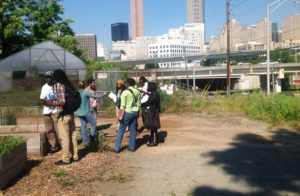This publication from ATTRA identifies the unique benefits of high tunnels to urban farmers.
It covers the basics of siting and constructing a high tunnel, as well as some of the policy and zoning challenges urban growers face when planning to erect a tunnel. It also discusses high tunnel management, including soil fertility, irrigation, and disease and pest control. Finally, it includes resources on intensive crop production and other uses for high tunnels.
Table of Contents

Introduction
High Tunnel Benefits for the Urban Grower
Installing a High Tunnel in the City
Urban High Tunnel Management
Conclusion
Case Study: Elijah’s Promise
References
Further Resources
Introduction
High tunnels have been helping farmers manage risks and increase profits for a long time. Now urban growers are using these simple structures to help them achieve these same goals, while facing unique challenges associated with urban farming. Tunnels are being used on rural and urban farms in many different ways, but they can off er special advantages and can be more profitable if they are being used close to densely populated urban and peri-urban areas
(Butler and Bauer, 2013).
High tunnels, also referred to a s hoop houses, are low-cost, usually unheated, metal-tube structures covered with one or two layers of greenhouse plastic to create a protected environment for crops.High tunnel end walls are usually wood framing covered by plastic or plywood. The side walls are often designed to roll up or down with a simple hand or electric crank to help ventilate the tunnel for temperature and humidity control. The added layer of protection created by these structures, when installed correctly and managed well, can expand the growing season into the winter and allow for early harvests in the spring. When temperatures fall below freezing at night, the minimum temperature in a high tunnel can be 6° higher than outside, and if low tunnels are used over the growing beds inside a high tunnel, 9° can be gained ( Wien, 2006). High tunnels can add at least four weeks to the beginning and end of the normal growing season, giving the urban grower a hand up in expanding and extending markets, growing more variety, and adding resilience to the farm.
High tunnels extend the season by protecting crops from harsh field conditions caused by wind, rain, and frost, and also can protect crops from pests and diseases that affect outside field crops. But unique conditions are created inside a high tunnel, which can lead to specific soil-fertility problems along with specific pests and disease problems (Blomgren et al., 2007). Because of this, high tunnels require an extra degree of management to ensure a quality crop and good production rates.
Continue reading High tunnels in Urban Agriculture
Written By: Chris Lent, NCAT Agricultural Specialist





